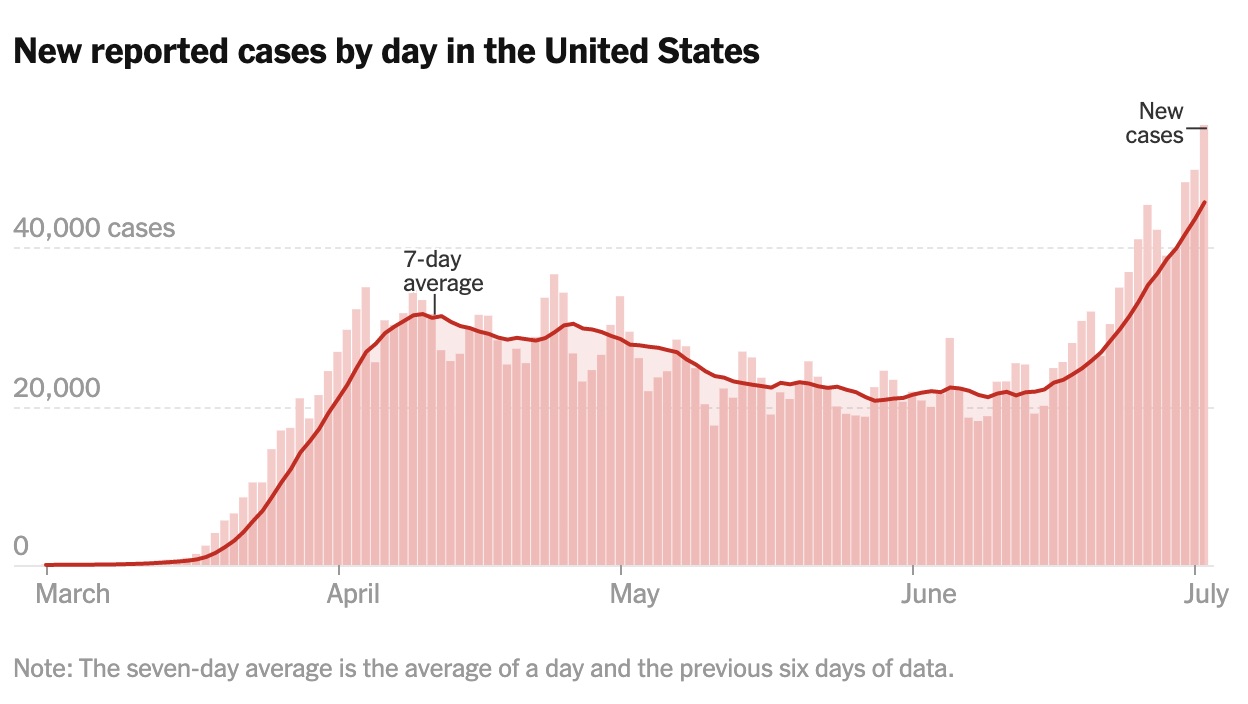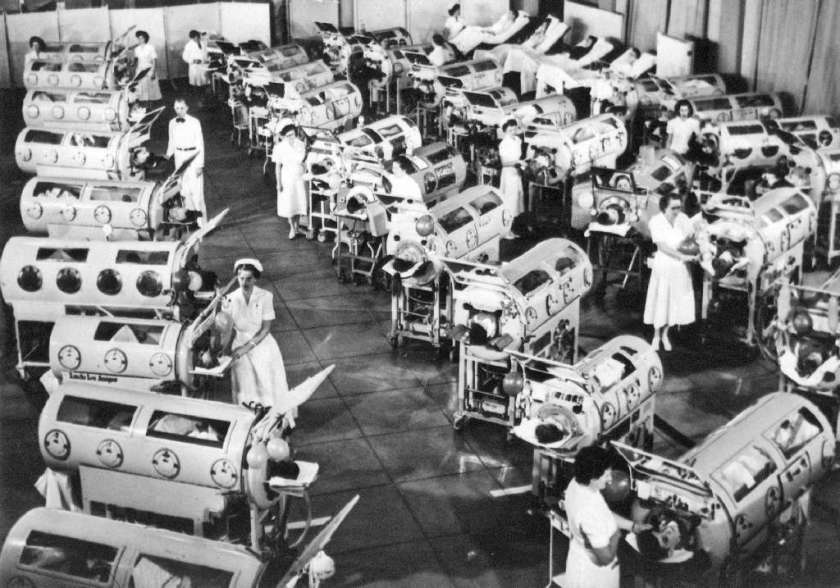A commentary on coronavirus and fear

Source: NY Times coronavirus tracker https://www.nytimes.com/interactive/2020/us/coronavirus-us-cases.html#cases
A commentary on coronavirus and fear
I believe that one primal force predominantly drives our decisions, determines our tribe, and frames the story that we tell ourselves. That force is not love, or hate, or desire. It’s fear. If you could truly self-examine and name what you are most afraid of, I could probably describe your worldview and your voting history and many choices you’ve made that you thought you were making for circumstantial reasons.
The coronavirus pandemic has increased fear across the board. But what each of us fears varies a lot. From the person who has literally not walked outside of their home since March, to the person who has knowingly attended a house party with a fever, the thing we are most afraid of is dictating our opinions about mask wearing, restaurant closures, stay-at-home requests, and all the rest of the non-pharmaceutical interventions that can keep the epidemic in check.
Strong national leadership could have minimized this problem by giving us a common narrative sympathetic to both the right and the left. What should we fear? How will we cope? What values will we use to make choices? Can we frame our choices in terms of national service for the common good rather than individual autonomy? In my opinion, this has been the great underlying failure of Trump in this crisis. Messaging and storytelling is arguably the president’s most important job. Would a general conduct a war without telling the foot soldiers who the enemy is, why they should care, what they’re being asked to sacrifice, and what are hopeful signposts on the road to victory? Americans could have united behind a stated goal with objectives that each of us felt we had something to contribute to. But instead of seeing ourselves as part of a larger campaign on a shared mission, each of us has constructed our own story based on our experiences.
The absence of a shared national narrative regarding the pandemic has weakened us and left us without a plan. We’re each battling our own demons, the things we fear most. America is simultaneously waging a regional guerrilla war against coronavirus and a civil war against ourselves.
**************************************
In the past month I’ve seen a shift in the national fear balance from COVID toward fear of the containment strategy: Fear of economic ruin. Fear of loss of privacy and loss of liberty. Fear of vaccines (that’s a topic for another day).
This shift undermines efforts by states and counties to keep the curve flat. Governments can issue mandates but without the support of the public their strategies will fail. Too many will refuse to wear a face covering even though asymptomatic individuals can spread the infection. Too many will gather with multiple households for a party. Too many will refuse to speak to a contact tracer about their exposures. This is what we are seeing now in California, Arizona, Florida, Texas as new records are being set daily for the number of positive coronavirus test results.
Aragorn: Are you frightened?
Frodo: Yes.
Aragorn: Not nearly frightened enough. I know what hunts you.
Fear is not a rational or metered response. I find it interesting that COVID-19, the disease itself, fails to push some of our biggest fear buttons. For one thing, the mortality rate is low enough that the average healthy American realizes their chance of dying from the virus is quite small. Therefore to motivate them to make sacrifices to contain the virus, they must be afraid on behalf of other people. This empathy is apparently a psychological step too far for many.
On the other hand, 130,000 Americans have already died of COVID-19 and although the risk is low for certain groups, it is not zero. I can think of two important reasons why many people do not have a greater gut-level fear of catching the virus. First, the majority of us still do not have a personal connection to anyone who has died. As the cases continue to spread geographically and to increase rapidly in number, that will change. We may find our collective resolve to act comes too late, only AFTER the deaths have touched us all.
Second, in our image-oriented society, pneumonia isn’t so scary. Suffocating in your diseased lungs may be a horrible way to die, but it’s not graphic in the way that some other infectious diseases are. I keep thinking about smallpox (pustules covering the skin of the face and body; if you want to see an image here) or bubonic plague (fingers and hands turning black, graphic image here), and how people’s response to COVID would be different if the disease caused a visible, external disfigurement that your friend with a positive test could post on their Instagram.
That COVID-19 primarily kills the elderly is unfortunately a factor in our complacency, too. Consider a comparison of our national response to SARS-CoV-2 versus the poliovirus. Polio does two things that trigger much greater fear than COVID-19: it strikes children, and it creates frightening images (children in leg braces or even iron lungs). A 1952 survey found that Americans feared polio more than anything except nuclear annihilation. Yet this was a time when the highest annual peak of cases (in 1952) was 58,000 with just over 3,000 deaths. For comparison, we are still in early days of the coronavirus pandemic and American cases are approaching 3 million, with about 130,000 deaths so far. Why so much more fear of polio (at the time) than COVID-19 today? Certainly this is part of the reason:

The image of the iron lung, and a child imprisoned within experiencing the entire world as a single mirror over their head, is utterly terrifying. A picture, it seems, is worth a thousand deaths.
Some Americans argue that the mainstream media and intellectual elites are stoking fear in order to advance an agenda unrelated to the virus itself. Some Americans see other media outlets manufacturing fear of false civic threats to resist containment efforts. There’s no question that fear is a powerful motivator and can be used to manipulate people. That’s why I have consistently tried to be calm in my discussion of the pandemic. Each of us needs to balance our fears in a way that allows us to find a sustainable balance between caution and paralysis, between doing nothing to impede the virus and locking down everything. At the moment, it seems some of us could use a little more fear.
Amy Rogers, MD, PhD, is a Harvard-educated scientist, novelist, journalist, and educator. Learn more about Amy’s science thriller novels, or download a free ebook on the scientific backstory of SARS-CoV-2 and emerging infections, at AmyRogers.com.
Sign up for my email list
Share this:



0 Comments